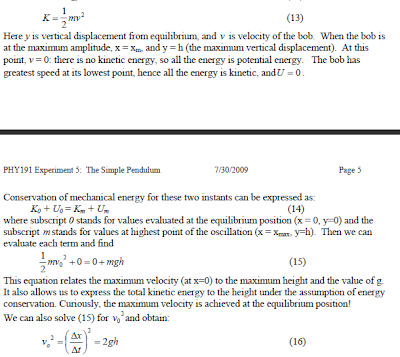The Proof for the Simple Pendulum equation that I WANNA FIND FOR AGES!!
http://www.pa.msu.edu/courses/PHY191/exp5.pdf



The Proof for the Simple Pendulum equation that I WANNA FIND FOR AGES!!
http://www.pa.msu.edu/courses/PHY191/exp5.pdf



char strNames[256];
scanf("%d", &a);
//this 2 functions cannot be used after scanf because the scanf will post a newline character after execution and gets or fgets will regard it as an input and hence will not prompt for input.
gets(a);
fgets(a, strlen(a), stdin);
| Electrostatic Potential The amount of work that I need to do to move a single charge from very far away, to that particular point near the source of electric field, which gives the following V = kq/r or from another point of view, the work required to move a single charge from the 2 points V1 - V2 = W/q or from another point of view, the (distance moved x Force required to move a single charge) V1 - V2 = (F / q) d Electric Energy eV from W = qV, we get Energy = Coulombs x Work per Coulombs for a single electron or proton, 1 coulomb = 1.6 x 10^-19 = e so the Electric Energy of a accelerating electron can also be given by Ee = eV = 1/2 mev^2 Conservative Field As long as the difference in altitude is the same, no matter what weird path taken, the energy obtained by moving from this altitude, to the other altitude is the same,. Equipotential Surfaces Why a conductor has equipotential everywhere on it? When initially, a charge is introduced to the conductor, of course, there will be an electric field that disrupts the equipotential as the charge will generate an electric field and cause all the electrons to move around, running from high potential to low potential, UNTIL the electrons reaches a state where it is in its lowest potential, ( for electrons this should be highest potential available), by that time, the potential within the conductor should be everywhere zero. thats when we get E = 0 V= Constant |
Power MOSFETs are at risk of thermal runaway. As their on-state resistance rises with temperature, if the load is approximately a constant-current load then the power loss rises correspondingly, generating further heat. When the heatsink is not able to keep the temperature low enough, the junction temperature may rise quickly and uncontrollably, resulting in destruction of the device.P Type and N Type Semiconducting Materials

Quoted from MIT OCW 18.02 fall 2007So, that means geometrically, my two vectors are going more or less in the same direction. They make an acute angle. It's going to be zero if the angle is exactly 90°, OK, because that's when the cosine will be zero. And, it will be negative if the angle is more than 90°. So, that means they go, however, in opposite directions. So, that's basically one way to think about what dot product measures. It measures how much the two vectors are going along each other.